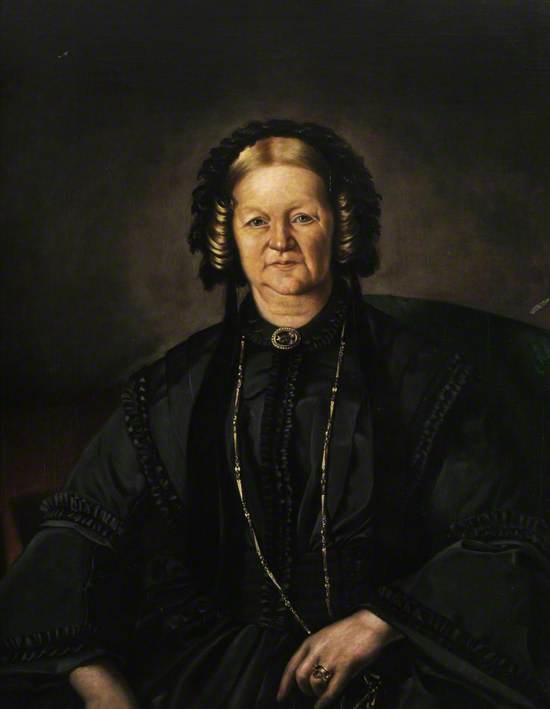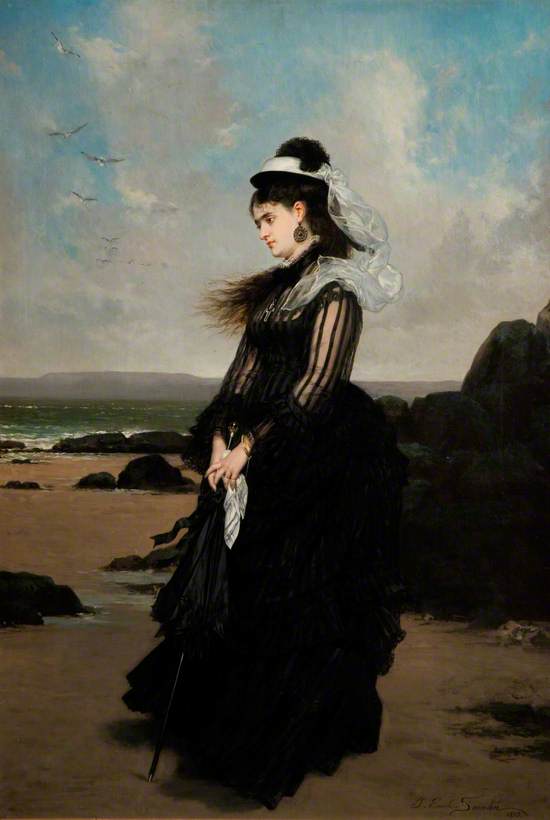Portrait of 19th Century Woman in Black Dress
The Victorians' fascination with death affected many aspects of their lives, including the way they dressed. Mourning behaviour in Britain developed into a complex set of rules in the 19th century, and it was customary for families to wear black mourning clothes as a mark of respect upon the death of a family member or friend. Queen Victoria, the original 'Woman in Black', famously exceeded the traditional period of mourning of up to two years for widows by remaining in black for the rest of her life after the death of Prince Albert in 1861. This exhibition explores some of the styles of female mourning dress worn during the Victorian period, using paintings from the latter half of the 19th century.
6 artworks
1858

Photo credit: National Trust Images
Augusta Frances East, Lady Hoare
Augusta Frances East, wife of Sir Henry Ainslie Hoare, 5th Bt was painted in Paris in 1858 by her friend Sir Frederic Leighton. This sombre portrait shows Augusta dressed all in black with red roses in her hair. Having the money to afford proper mourning dress and accessories became a status symbol, with tailors and entire warehouses devoted to the fashion. From the Regency period to the end of the 1860s, there was no fashion accessory as versatile and ubiquitous as the shawl, and Lady Hoare's black shawl was a popular accessory for mourning dress. Augusta was possibly in mourning for her husband's uncle who had died the year before this portrait was painted, leaving Sir Henry as the successor to the baronetcy.
1865

Photo credit: Southampton City Museums
Mrs Hannah Ransom
Mrs Hannah Ransom is depicted wearing a black crinoline dress with bell-shaped sleeves and a black bonnet. For deepest mourning, clothes were expected to be all black to symbolise spiritual darkness. Dresses for deepest mourning were usually made of paramatta silk or bombazine and trimmed with crape. Although public mourning officially ended for Prince Albert in February 1862, such was the level of sympathy for the queen that many of the middle classes remained in mourning for much longer for their own deceased relatives. Mrs Ransom is also wearing a brooch that appears to be made from jet. Jet was made fashionable by Queen Victoria in 1857 after she wore a necklace of it in her mourning dress for Princess Victoria of Saxe-Coburg and Gotha.
Mrs Hannah Ransom 1865
Heath
Oil on canvas
H 88 x W 69 cm
Southampton City Museums
1873

Photo credit: The New Art Gallery Walsall
Woman in Black
Jules Émile Saintin's the Woman in Black (or The Tomb without Flowers) shows a fashionably dressed dark haired woman in a black silk striped mourning dress with bustled back staring out to sea (suggested as the resting place of a loved on). The model's accessories show how all encompassing mourning etiquette was on women's dress. She is painted wearing She wears a black hat with black feathers and a long diaphenous white ribbon, and holds a closed black umbrella and a white handkerchief with a black border, known as a funeral handkerchief. Her mourning jewellery includes a silver and jet cross around her neck, jet beaded earrings and jet and pearl rings. Pearls were said to symbolize tears in the Victorian period.
Woman in Black 1873
Jules Émile Saintin (1829–1894)
Oil on canvas
H 86 x W 61 cm
The New Art Gallery Walsall
1880

Photo credit: Manchester Art Gallery
The Artist's Mother
The feminist and suffragette artist, Susan Isabel Dacre, painted this portrait of her elderly mother between 1880-1884. Her mother is depicted wearing a dark cream coloured dolman mantele over a black dress with a black lace scarf round her head, pinned at the neck with a brooch. The colours worn by the sitter suggest that she was in half mourning, as she has introduced the muted cream/grey colour of her mantle back into her otherwise black wardrobe. Those subject to the etiquette of mourning were slowly allowed to re-introduce conventional clothing and colours into their dress at specific times. Changing your dress earlier was considered disrespectful to the deceased.
The Artist's Mother 1880–1888
Susan Isabel Dacre (1844–1933)
Oil on canvas
H 91.3 x W 73.7 cm
Manchester Art Gallery
1884

Photo credit: Victoria Art Gallery
Anna Bilinska (1857–1893)
The portrait of the Polish artist, Anna Bilinska-Bohdanowicz was painted by Bath born artist, Emmeline Deane in 1884. The pair had possibly met in Paris, where Bilinska was studying on an art course. Bilinska suffered the loss of both her father and her close friend Klementyna Krassowska in the year this portrait was painted. She is shown wearing typical mourning dress with what may be a black feather fan resting on her lap. The long silk crape mourning veil that Bilinska is wearing, fastened on to a bonnet, was often seen as a means of shielding the mourner, and allowing her to hide her grief. The world's chief manufacturer of mourning crape was the British company, Courtaulds, who manufactured 90,000 pounds worth of crape in 1865.
Anna Bilinska (1857–1893) 1884
Emmeline Deane (1858–1944)
Oil on canvas
H 128 x W 90.7 cm
Victoria Art Gallery
1888

Mrs Lowman
Whilst not much is known about the elderly Mrs Lowman, depicted in this 1888 portrait by Alfred Usher Soord, it could be presumed that she is a widow. A respectable widow was expected to wear full mourning dress for at least two and a half years after her husband's death. The entire mourning ensemble, usually consisting of a black silk or bombazine dress worn with either a 'weeping veil' covering the face outdoors, or a 'widow's cap' indoors, was colloquially known as "widow's weeds" from the Old English word waed, which roughly translates as 'garment'.
Mrs Lowman 1888
Alfred Usher Soord (1868–1915)
Oil on canvas
H 45.7 x W 35.6 cm
York Museums Trust
-

Heath
-

Frederic Leighton (1830–1896)
-

Emmeline Deane (1858–1944)
-

Susan Isabel Dacre (1844–1933)
-

Alfred Usher Soord (1868–1915)
-

Jules Émile Saintin (1829–1894)
Source: https://artuk.org/discover/curations/the-woman-in-black
0 Response to "Portrait of 19th Century Woman in Black Dress"
Post a Comment